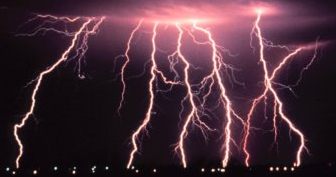
Photo Credit: NOAA Photo Library
National Weather Service Blog notes that:
June, July, and August are the peak months for both lightning and lightning fatalities
Slides from Feb 2008 AARC Presentation on Station Grounding and Lightning Protection by Alan Swinger, K9MBQ.
In April 2012, Joe Flamini, W4BXG, gave an AARC presentation on station grounding and lightning.His Powerpoint slides as PDF. Note that he plans to add explanatory text to the slides to make them more useful without a presenter standing in front of you.
Here are some of the protective devices shown in Joe’s slides. Annotations are mine (AK4OL), not Joe’s.
- Delta LA302-R whole house arrestor for 125/250V single phase systems(google products search)
- Polyphaser IS-B50LN-C0-MA. This is the HF version (-C0). Very hard to find used on ebay. The “-C1” can be used on VHF/UHF but not HF and is easier to find. Note that the -MA version is shown; you probably doon’t want that as that is the male to female version which is less than ideal for mounting to a bulkhead single point ground plate. This would be great to install directly on the back of a radio, except that is generally not a good place for it. Drop the “-MA” to get to female connectors. However, you can use the -MA if you already have long through wall coaxial feedthroughs installed. Substitute an “H” for an “L” in the part number for higher power transmitters and a “U” for an “N” to use inferior PL-259/SO-259 style “UHF” connectors. The “B” denotes bulkhead mount, don’t drop that if ordering new but if you get a good deal on a used one consider it. Costs around $65 new. For an extra $30-40, you can get the IS-NEMP-C0 instead, which is rated for electormagnetic pulse (EMP) events. Regular lightning arrestors are generally too slow to suppress an EMP surge. DX engineering has a number of polyphaser protectors.
- Mouser 650-GTCA28-601M-R05. A $0.53 Gas Discharge Tube (GDT) with rather mediocre specs. Not rated for EMP speed events. Allows about 1400V to go to your radio. This is a through hole (axial leaded version) so beware of lead inductance. Remember that the wires should always go directly to the suprressor and then from the suppressor to the device being protected; there should be no inductance in the connection to the supresssor is not in the path to the protected device. This device is only good for 5kA; an average stroke is 30kA and larger bolts may be 120kA and positive lightning 300kA. Some of the energy may be shunted before it reaches your protector. Also, it has no fail shorted mechanism; some have a metal bar that drops across the GDT when it overheats. GDTs which can handle 40-100kA are available but they also cost about $2-$13.
- Digikey 1.5KE15CADICT-ND TVS suppressor diode 15V breakdown for low voltage signals. Beware of axial leads.
- Mouser 576-P2703ABL (littlefuse P2703ABL) Sidac
Dennis Mennerich K4THE posted these links to lightning strike maps on the club email:
Strikestar lightning strike map: Last 24 hours, US
Strikestar lightning strike map: Last 60 minutes, Northeast
Virginia forecast http://www.nws.noaa.gov/mdl/radar/NE_probltg.gif
National forecast http://www.nws.noaa.gov/mdl/radar/smv_03h_probltg.gif
Recent world history http://wwlln.net/
He also posted some links to the lightning protection instutute articles and some ARRL articles but there is an ARRL page (linked below) had all of those links as well as the Polyphaser library and the ARRL EMP articles and a number of others.
ARRL Articles and links regarding Lighting and EMP protection
